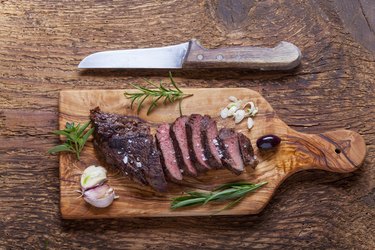
Pan-seared sirloin steak finished in the oven maximizes the flavor in your steak. You may be able to use only one pan for the entire cooking process. A dutch oven or cast-iron skillet can pan-sear and oven-bake a sirloin in one pan.
Sirloin Steak in Dutch Oven
Video of the Day
Sirloin steak in a dutch oven is an excellent choice when pan-searing and finishing a steak in the oven. A dutch oven is an oven-safe pot that can be placed on the stove top, or in the oven itself.
Video of the Day
Tip
If you marinade the sirloin, you should marinate it for at least 30 minutes. Longer marinades, such as overnight, can further enhance the flavor.
Prior to cooking, take the steak out of the refrigerator and let it get up to room temperature. When the steak is at room temperature, heat 2 teaspoons of olive oil in the dutch oven, over high heat on the stove.
Once the olive oil is hot, place the sirloin steak in the dutch oven. The olive oil may jump some when the steak touches the pan, so use tongs, or other tools, to place the steak in the dutch oven initially.
Next, sear the sirloin steak for 2 to 2 ½ minutes per side. Flip the steak with tongs or a spatula. Once you finish searing the second side, place the lid on the dutch oven, and place the whole thing in your oven. Set a timer to between 8 and 10 minutes. You can use a food thermometer to check how done the steak becomes, as per your tastes. When the steak reaches 145 degrees Fahrenheit, it is medium-rare. If it reaches 160 degrees Fahrenheit, the steak is cooked medium, and if it reaches 170 degrees Fahrenheit, it is well-done.
Tip
You can adjust cooking times to cook the steak to your desired level of doneness. According to the USDA, the internal temperature should reach a minimum of 145 degrees Fahrenheit for safety. You can use an food thermometer to check the temperature.
Once the steak is removed from the oven, you should let it rest for a few minutes. Letting the sirloin rest helps prevent the juices from leaving the meat, which helps keep the flavor in the steak, and makes it more palatable.
You can take similar steps cooking the steak in a cast iron skillet and oven. Similar to a the dutch oven technique, you can place the cast iron pan directly in the oven. If you don't use either a cast iron skillet or dutch oven, you will need to transfer the steak to a cookie sheet, or other oven-safe pan, after searing both sides. Doing this creates extra dishes, but will produce similar results in the steak.
Pan-Seared Sirloin Nutrition
Pan-searing sirloin can add a savory flavor to the meat. When you pan sear steak, it creates a caramelized crust on the outside of the meat that adds extra flavor. However, pan-searing sirloin can add extra calories and fat to the steak. So depending on your dietary restrictions, you may need to pay attention to how you are searing the steak.
According to the USDA, a serving of sirloin steak, trimmed of fat, contains 186 calories and nearly 9 grams of fat. If you pan sear sirloin steak with butter, you are adding extra saturated fat and calories. However, like all food, steak offers more than just calories and fat. According to the National Center for Biotechnology Information, steak provides high grade protein and other essential macro- and micro-nutrients.
Alternatively, you can sear your sirloin steak in olive oil instead of butter. Though this will also add calories, olive oil is a better choice than butter. Finally, if you use a non-stick pan, you can sear the steak without adding any extra fat or calories.
- U.S. Department of Agriculture: "Beef, Top Sirloin, Steak, Separable Lean and Fat, Trimmed to 0" Fat, Choice, Cooked, Broiled"
- U.S. Department of Agriculture: "Safe Minimum Internal Temperature Chart"
- Proceedings of the Nutrition Society: "The Role of Red Meat in the Diet: Nutrition and Health Benefits"